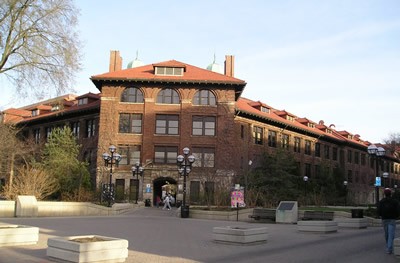West Hall
Introduction
Text-to-speech Audio
West Hall tells a story of how research initiatives across the University of Michigan were mobilized in the service of the Cold War. As you can see, West Hall appears old and outdated, but it has been a crucial part of the University for decades. It was here, and at other places on campus, where research, such as social science, natural science, engineering, and even the humanities were militarized during the Cold War. These research initiatives included defense applications to combat the spread of communism, and to expand and consolidate the influence of the United States around the world.
Images

Backstory and Context
Text-to-speech Audio
Formerly known as the New Engineering Building, West Hall was designed in 1904, placed intentionally to connect the new east wing of campus with the original southeast end. It was designed by George Mason and Albert Kahn, a Detroit-based architectural firm that designed several other buildings on campus. In addition to becoming the new home for engineering on campus, it was the first site of the College of Architecture (which used to be within Engineering). It didn’t get the name West Hall until 1923, when East Engineering was built across the street at East University Avenue. Since the College of Engineering relocated to North Campus in the mid-1980s, West Hall has housed various academic units like the College of Literature Science and the Arts as well as the School of Information. The Department of Anthropology, the Department of Astronomy, and the Department of Statistics, are currently in the building.
We bring you here today to discuss how the University was complicit in military research during the Cold War, as West Hall, then West Engineering, and its historical function serve as reminders of the ways in which this institution is tied to these histories. By 1960, leaders in higher education placed research at the center of academic life, believing it was a way to fuel economic innovation. University President Harlan Hatcher himself believed that “the University was not a place for vocational training” and that “faculty should excel in teaching and research” as a way to bolster the liberal arts approach.
Nonetheless, some of this research was directly connected to US military efforts, including experiments developing chemical and biological warfare for military applications in Vietnam. Harlan Hatcher himself served as a board member of the Institute for Defense Analyses (IDA), a nonprofit organization that partnered the United States Defense Department and twelve research universities, effectively creating a think tank for government-sponsored research in war weaponry. By allocating university research initiatives in the service of the war effort, the IDA made the University of Michigan complicit in the United States’ militarization efforts.
Universities, like Michigan, also became training grounds for astronauts entering the burgeoning US Space Program, a result of the space race, an extension of Cold War competition between the United States and Soviet Union.
Students across the nation began organizing against the militarization of University research. For them, it was an extension of their anti-Vietnam War activism, enabling them to turn inward to see how their University community was complicit in the war effort. One explicit example of critique of the University’s complicity in the military-industrial complex is the August 8, 1966, student-organized protest against Dow Chemical, a Michigan-based chemical company that produced napalm. Unsurprisingly given what we’ve already learned about its prominence in the Ann Arbor community, the Students for a Democratic Society—who, you might have noticed, have been sort of “recurring characters” in this tour—also published an exposé condemning the Institute for Defense Analyses, arguing that it had nothing to do with education and simply withheld resources from students by sending professors on leave to do research with the organization.
The only remaining part of the College of Engineering still on Central Campus is the Marine Hydrodynamics Laboratory. While most of us walk by this building multiple times a day, many may not realize that this is here.
Sources
Bentley Historical Library. “West Hall.” A Historical Tour of the University of Michigan Campus.https://bentley.umich.edu/legacy-support/campus_tour/westhall.php
Brown, Obadiah, Maria Buczkowski, Chris Haughey, Matthew Lassiter, Andreea Matei, Kevin Trierweiler. Resistance and Revolution: The Anti-Vietnam War Movement at the University of Michigan, 1965-72 (online exhibit). https://michiganintheworld.history.lsa.umich.edu/antivietnamwar/
“The Hatcher Administration.” In The University of Michigan: An Encyclopedic Survey. Edited by Wilfred B. Shaw. Ann Arbor: University of Michigan Press, 1941-. https://quod.lib.umich.edu/u/umsurvey/AAS3302.0005.001/1:3?rgn=div1;view=fulltext
Olivas, Michael A. and John R. Thelin. Going to College in the Sixties. Baltimore: Johns Hopkins University Press, 2018.
Rhode, Joy. “Armed with Expertise: The Militarization of American Social Research during the Cold War” (lecture). Gerald R. Ford School of Public Policy, University of Michigan, April 14, 2014. https://fordschool.umich.edu/events/2014/armed-expertise-militarization-american-social-research-during-cold-war?theme=ipc
Schrecker, Ellen. The Lost Promise: American Universities in the 1960s. Chicago: University of Chicago Press, 2021.
“West Engineering—West Hall 1904/1910.” Historical Marker. https://www.hmdb.org/m.asp?m=181702
